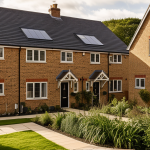Core Concepts of Minimalist Home Decor
Minimalist design principles focus on simplicity, functionality, and intentionality. At its core, minimalist decor basics emphasize clean lines, uncluttered spaces, and purposeful placement of items. This approach reduces visual noise, creating calming environments that highlight quality over quantity.
A key characteristic of minimalist home decor is the restraint in ornamentation. Every object holds a purpose or aesthetic meaning, avoiding excess or duplication. Surfaces remain mostly clear, and storage solutions help maintain order without overwhelming the space.
Also to read : What are innovative ways to use multifunctional furniture in UK homes?
Modern minimalist living often draws inspiration from open layouts and neutral palettes, promoting balance and ease. The interplay of natural light and simple, well-chosen furnishings enhances the feeling of spaciousness. These elements together cultivate an environment that supports mindfulness and relaxation.
In summary, understanding and applying minimalist design principles means focusing on essentials while embracing simplicity. Adopting these concepts can transform your home into a serene haven, reflecting both function and form harmoniously.
Additional reading : What Are the Secrets to Creating a Cozy Home Atmosphere?
Starting Your Minimalist Transformation
Embarking on minimalist living begins with effective decluttering tips that make the process manageable. Start by sorting belongings into three categories: keep, donate, and discard. This method ensures clarity and eases decision-making. How do you start minimalism when faced with a full home? Focus on one room or area at a time to avoid overwhelm. Prioritise spaces with high daily use for the most immediate impact.
Home organisation techniques underpin a lasting minimalist lifestyle. Use storage solutions that hide belongings yet remain accessible, such as under-bed drawers or sleek shelving. Label systems can streamline maintenance and reduce clutter recurrence.
Common challenges include emotional attachment to items or uncertainty about what to keep. Address these by asking if objects serve a practical or meaningful role. This approach aligns with minimalist design principles by valuing purpose over possession. Incremental progress builds confidence, turning decluttering into a sustainable habit.
By adopting smart organisation and confronting typical obstacles, your minimalist decor basics evolve naturally. This foundation supports the peaceful, orderly environment that defines modern minimalist living.
Designing with Intent: Furniture, Layout, and Materials
Designing with intent means selecting minimalist furniture that balances form and function. Opt for pieces with clean lines, simple shapes, and multi-functionality to support minimalist design principles. For example, a sofa with hidden storage combines practicality with sleek aesthetics, reducing visual clutter while serving multiple purposes.
Room layout ideas should promote openness and easy movement, maximizing natural light. Avoid overcrowding by spacing furniture thoughtfully, which enhances the calming effect characteristic of modern minimalist living. Placing larger items against walls opens central floor areas, creating an airy feel.
Choosing minimalist materials solidifies the decor’s subtle elegance. Natural finishes like wood, stone, and metal convey quality and durability while resisting ornate details. Matte surfaces and neutral tones complement these textures, keeping the overall look cohesive.
Functional decor items—such as simple lighting fixtures and unobtrusive shelving—maintain visual harmony. These elements work silently in the background, ensuring every object serves a purpose aligned with minimalist design principles. This intentional approach transforms spaces into tranquil, balanced environments.
Colour Schemes and Visual Inspirations
Minimalist colour schemes rely heavily on neutral tones to cultivate a serene and cohesive atmosphere. Whites, beiges, soft greys, and muted earth tones form the foundation of most minimalist style palettes. These shades promote openness and allow architectural features or furnishings to subtly stand out without overwhelming the space.
How do neutral tones enhance minimalist decor basics? Their understated hues prevent visual clutter, creating balance and calm. For example, pairing light walls with natural wood floors introduces warmth while maintaining simplicity. Accent colours, when used, are restrained and often drawn from nature to preserve harmony.
Visual examples from modern minimalist living often showcase monochromatic schemes, where different tones of a single colour add depth without complexity. Mood boards help translate these ideas by combining textures and tones, guiding the overall design. Incorporating matte or soft finishes on surfaces enhances the gentle feel, avoiding shiny distractions.
In sum, minimalist colour schemes emphasize subtlety and cohesion. Using neutral palettes thoughtfully supports minimalist design principles, encouraging spaces that feel airy, ordered, and inviting.
Transformations and Achievable Ideas for Every Space
Embarking on a minimalist decor journey transforms any area, whether a studio apartment or a multi-room home. Before and after minimalist decor photos exemplify dramatic improvements in spaciousness and calm. They highlight how removing excess and focusing on essentials redefines a space’s flow and function.
Budget-friendly ideas make minimalism accessible. Simple swaps—like replacing bulky furniture with streamlined alternatives or using multifunctional storage—reduce clutter without costly renovations. Items such as open shelving, neutral linens, or compact side tables can refresh a room’s look efficiently.
Adaptations to different spaces ensure minimalist principles fit all lifestyles. In small space minimalism, vertical storage and light colours maximize visual roominess, while larger rooms benefit from deliberate furniture placement to create balance. Each minimalist room reflects intention, combining practicality with aesthetic clarity.
By exploring achievable ideas tailored to various rooms and budgets, you can realize the benefits of minimalist decor basics. This approach supports modern minimalist living, encouraging serenity and order, regardless of your space’s size or your décor budget.


